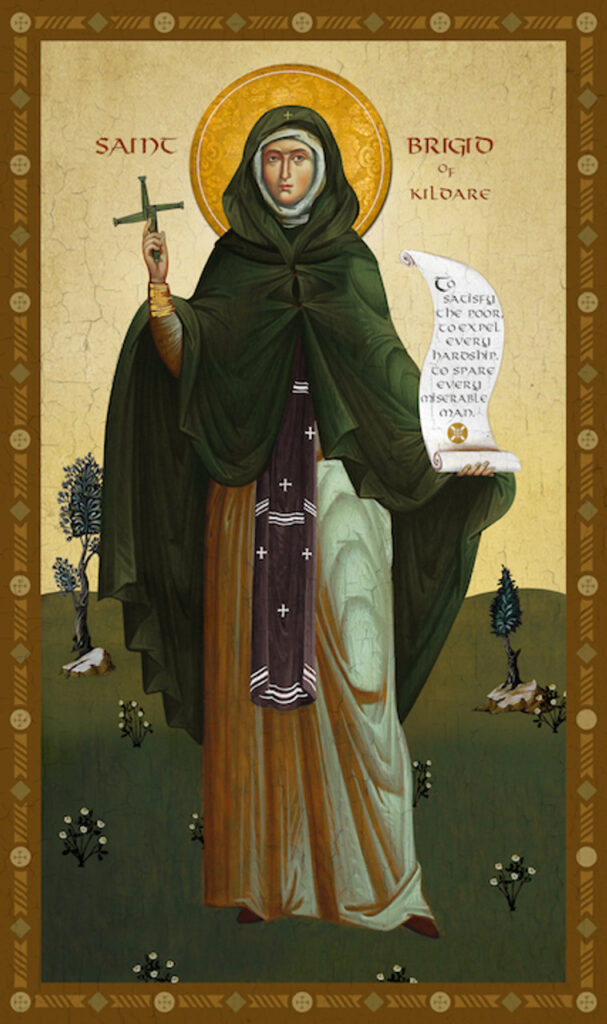
Image source taken from Icon of St. Brigid of Kildare
Material sources distilled from the Book, ”St. Patrick after the ancient narrations” by Rev. Phillip Lynch C.S.Sp. published in 2013 by James Lynch. Other material sources are distilled from Omnium Sanctorum Hiberniae
St. Brigid of Kildare
The new trend of presenting Brigid as a goddess who then became a Christian needs to be looked at closer. It’s a growing ideology without solid foundation. A goddess is a false deity, who wants to be like the Most High God. Those who worship false gods are in the act of idolatry. We know that Jesus came to make known to mankind, on the One True God, who is the Most High, and to turn mankind away from idolatry. Jesus also came for our salvation. Bridget desired that people follow Jesus so that they too can know the one True God and reach salvation. We can consider St. Peter in the book of Acts 10:24-26, when he was worshiped as a god. It says ”… when Peter came in, Cornelius met him, fell at his feet, and worshiped him. But Peter helped him up, saying, “Stand up. I too am a mere mortal”. So to consider Brigid as a goddess is to do a great disservice for all she stood for.
So lets take a look at Brigid, who she really is…
Various writings were compiled in ‘’The Life of St. Brigid’’ by Cogitosus, and here are some points of interest on St. Brigid. These ancient sources tell us that Brigid belonged to the early age of Christianity in Ireland. She was born of human stock and generated from Christian parents of noble birth, and baptised by St. Patrick. Brigid was born at Faughart, Dundalk formerly of the province of Ulster. She lived 80 years, a life of virtue from the cradle to the grave.
The name Brigid means virtuous in Irish. She was so virtuous, that she earned the title, Mary of the Gaels. This means she imitated Mary, the Mother of God, while she promoting Christianity in Ireland. Brigid was veiled with seven of her friends by Bishop Mac Caille. On that day, the wooden base of the altar she touched ‘flourishes fresh and green to the present day. She travelled by chariot, establishing religious houses in Ireland, gaining thirteen thousand nuns under her rule.
She founded a monastery in Kildare, a name which means church of oak. The ancient Leabhar Breac mentions the building of this monastery at the time of St. Brigid. She worked closely with St. Conleth whom became bishop of Kildare, thanks in part to Brigid’s great influence and recommendation. It was at St. Brigid’s monastery that Cogitosus wrote her biography one hundred years after their founder passed away from this world.
In her life, Brigid milked one cow three times a day to feed three abbots. She replaced a king’s lost fox with another one, who miraculously knew the same tricks as that missing fox. Brigid found a secret store of honey under the floor boards just in time to give to a beggar who was came knocking at her door. A leper came to Brigid’s door looking for beer, but Brigid had no beer to offer him. But she got some water and called down God’s blessing on the water. With her faith in Jesus Christ, the water became changed into a fine beverage.
The story of St. Brigid’s Cross
Brigid was attending to a dying pagan noble, who was falling in and out of sleep. Brigid at one point took some rushes from the ground and began to weave them into a Cross. The noble man was curious, and in his feeble condition wanted to know what she was making? He somehow felt better for this strange Cross. Brigid used this Cross to explain Christianity and the salvific power of Christ, so that men learn of the one True God and reach salvation. This noble pagan was open to hearing more, and he became baptised before he died.
St. Brigid foretold to St. Patrick of St. Colmcille who would convert the Gaels in the north west of Ireland. These three saints are now buried together in Downpatrick in Ulster. They are the three national saints of Ireland.
St. Brigid’s feast day is celebrated on the 1st February, she is a patron saint of Ireland
In the 8th century her feast day was celebrated in Luxemburg. Her feast day is recorded in the Calendar of St. Willibrord. Her relics are Venerated in the abbey of San Maurice in Switzerland. Also, Bridewell in London is named after Brigid, for Bride is the anglicised form of Brigid.